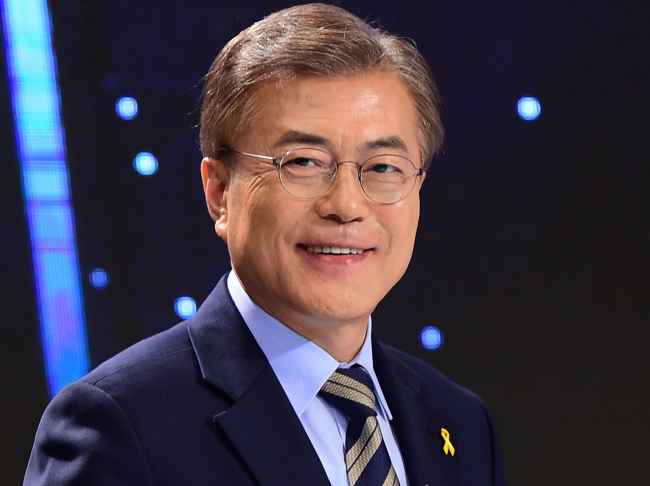With only six days remaining to the election, Moon Jae-in’s lead appears to be nearly insurmountable: He garnered 42.4 percent of support in the latest Realmeter poll released Wednesday, against the next two candidates who stand tied at 18.6 percent.
The race, however, is not over yet. An upset is still possible, although not likely.
Here is a look at three key variables that could significantly alter the dynamics of the race in the final stretch to the May 9 election.

Moon Jae-in of the Democratic Party of Korea at Tuesday’s final presidential TV debate hosted by the National Election Commission. (Yonhap)
Demographically, voters in their 50s hold the key in this election, according to Yoon Hee-woong of Opinion Live, a local research firm.
“Which way this group will vote will likely determine the result of the upcoming election,” he told The Korea Herald.
According to the National Election Commission, voters aged 50-59 amount to 8.46 million people or 19.9 percent of the electorate. It is the second-biggest age group after those in their 60s.
What makes them important is that this group stands in the middle of a generational divide. While those under 50 support the liberal front-runner Moon, those over 60 favor conservative or centrist candidates.
In Wednesday’s poll by Realmeter, Moon garnered 35.6 percent of support among 50-something voters, while Hong earned 26.2 percent and Ahn 17.7 percent.
In previous elections, 50-somethings have displayed a clear conservative tendency. In 2012, when conservative President Park Geun-hye was elected, this group voted in sync with those over 60 to support Park, reporting the highest turnout among all age groups of 82 percent. Yet, in the upcoming poll, the voters in their 50s are divided among three major contenders, with many still remaining undecided.
“There is an ever growing mobility of voters in their 50s, moving from one candidate to another instead of showing blind loyalty to a particular candidate,” said Bae Jong-chan an analyst for pollster Research and Research.
If Moon manages to win the hearts and minds of the floating voters in their 50s in the next few days, he could be unstoppable.
Variable 2: Conservative voters
Numerous polls suggest the outcome of Tuesday’s presidential election is a forgone conclusion, but the country’s divided conservative voters could still tip the scales.
About 26 percent of South Koreans identify themselves as conservatives, one recent poll showed, their support remains divided among three candidates -- two conservative and one centrist -- with the backing of established parties. (The actual number of right-leaning voters is believed to be much higher. In the 2012 election, which was the ultimate conservative-liberal showdown, then conservative flagbearer Park Geun-hye had garnered 52 percent of votes.)
With each trying to maximize their appeal to conservatives, voter sentiment has changed dramatically, hinting at the possibility of right-wing voters rallying together behind a single candidate to tip the balance.
For much of the short campaign period, a large chunk of conservative voters had backed Ahn Cheol-soo of the People’s Party, despite the party’s obvious connections to past left-leaning administrations.
The party’s stronghold is the traditionally progressive North and South Jeolla provinces, and its current leader is Rep. Park Jie-won, formerly one of President Kim Dae-jung’s closest allies.
A Gallup Korea poll conducted in the first week of April showed that 42 percent of respondents who identified themselves as conservative supported Ahn. In comparison, the figure for the self-proclaimed conservative champion Hong Joon-pyo of the Liberty Korea Party stood at 22 percent.
Since then, much has changed.
A Gallup poll released Wednesday shows that Ahn is supported by 20 percent of conservative voters. Yoo Seong-min of the troubled Bareun Party is the choice for 10 percent of the conservative respondents, while Hong Joon-pyo of the Liberty Korea Party is supported by 43 percent of them.
Variable 3: Yeongnam region
Yeongnam -- a collective term referring to the southeastern North and South Gyeongsang provinces, Daegu, Ulsan and Busan -- has always been a highly predictable region in elections: Almost always, conservative candidates claim sweeping victories.
But the aftermath of the scandal-ridden fall of President Park and the consequent divide of the conservative camp evidently shook the political faith of people there, morphing them into one of the largest swing voter pools.
But much to the liberal camp’s dismay, the Yeongnam region has recently seemed to swing back to its conventional political tendency. Voters there are fast gathering around Hong, recent polls suggest, and may once again pull up the turnout for the conservative camp, posing a considerable threat to liberal flag-bearer Moon.
According to Realmeter’s survey released Wednesday, the hard-line conservative leads Moon, 37.3 percent to 30.7 percent, in North Gyeongsang Province and Daegu.
Further south in Busan and South Gyeongsang Province, however, Moon leads with 40.7 percent, followed by Hong at 27.5 percent and centrist Ahn at 13.5 percent.
The southern Yeongnam happens to be the birthplace of the three candidates. It was also the home of late liberal President Roh Moo-hyun, a close friend and political mentor of Moon. Bongha Village in South Gyeongsang Province’s Gimhae -- where Roh was born, retired to and died -- has become a symbol of liberal struggles against conservative powers.
By Choi He-suk, Bae Hyun-jung and Bak Se-hwan (
cheesuk@heraldcorp.com) (
tellme@heraldcorp.com) (
sh@heraldcorp.com)






![[Graphic News] More Koreans say they plan long-distance trips this year](http://res.heraldm.com/phpwas/restmb_idxmake.php?idx=645&simg=/content/image/2024/04/17/20240417050828_0.gif&u=)